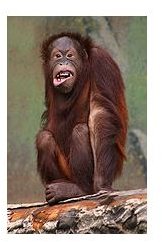Whistling Orangutans: Insight Into Speech
Accidents often lead to discoveries.
The caretaker who looks after Bonnie, a female orangutan who is currently residing at the Smithsonian National Zoological Park in Washington, D.C., could not have imagined that her innocuous habit of whistling while doing her job and going through her daily routine would result in a scientific breakthrough. Yet when Bonnie suddenly started whistling, this is exactly what happened: her newly acquired behavior allowed zoologists to make new hypotheses in the study of language evolution in primates.
Orangutans are a species of humanoid apes who are known for their highly developed mental ability. In the wild, they have been observed to use tools and communicate with various exclamations. Orangutans also invent new sounds and spread them within the community; these sounds always serve a certain purpose, such as warning from an approaching predator or announcing a particular activity.
Following these observations, scientists concluded that Orangutans cannot control or master their voices. They settled for a theory that says that the apes’ vocalizations depend on instincts and contingent circumstances – such as a mating drive or a danger. Now, it turns out, some apes can – like humans – learn new sounds and use them in a controlled and deliberate fashion.
The discovery of Orangutans’ ability to expand their “vocabulary” by borrowing sounds from another species puts what we knew about language evolution in a new perspective. If apes are much more flexible and adaptive when it comes to sound and auditory communication than previously thought – can this knowledge build another link in understanding the evolution of human language?
As if to answer this question, at least partially, additional research showed that yet another Orangutan picked up the sound from Bonnie, the original orangutan whistler. Thus, in social situations new sound patterns receive distribution; whistling became a part of a “language” of a small community of apes.
It has not yet been determined what function the whistling serves. It’s possible that it was done for its own sake – researchers said that it was “spontaneous” in nature – and maybe enjoyment or fun.
Maybe we should ask Bonnie?
